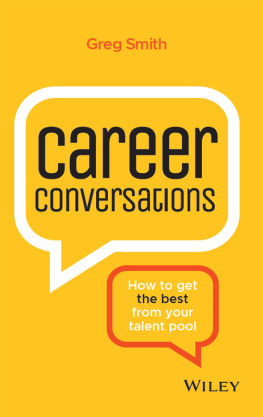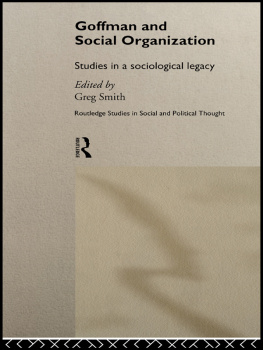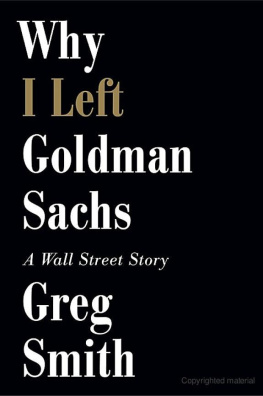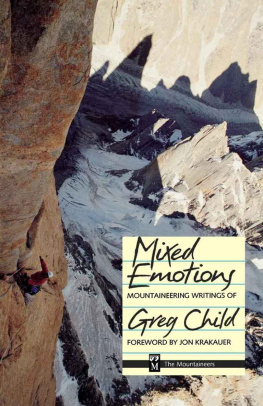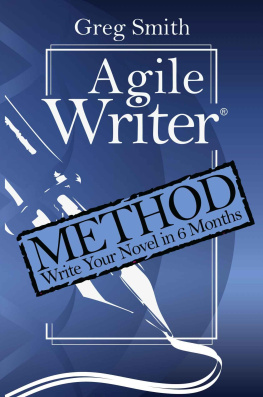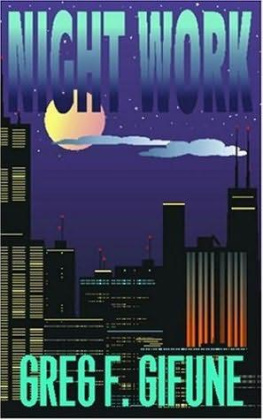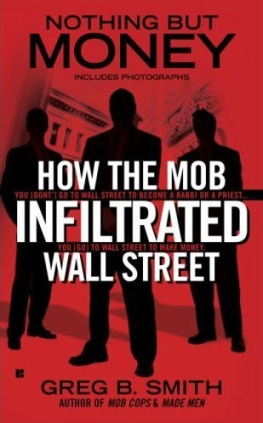Greg Smith - The Emergence of the Professional Watercolourist
Here you can read online Greg Smith - The Emergence of the Professional Watercolourist full text of the book (entire story) in english for free. Download pdf and epub, get meaning, cover and reviews about this ebook. publisher: Taylor & Francis (CAM), genre: Romance novel. Description of the work, (preface) as well as reviews are available. Best literature library LitArk.com created for fans of good reading and offers a wide selection of genres:
Romance novel
Science fiction
Adventure
Detective
Science
History
Home and family
Prose
Art
Politics
Computer
Non-fiction
Religion
Business
Children
Humor
Choose a favorite category and find really read worthwhile books. Enjoy immersion in the world of imagination, feel the emotions of the characters or learn something new for yourself, make an fascinating discovery.
- Book:The Emergence of the Professional Watercolourist
- Author:
- Publisher:Taylor & Francis (CAM)
- Genre:
- Rating:3 / 5
- Favourites:Add to favourites
- Your mark:
- 60
- 1
- 2
- 3
- 4
- 5
The Emergence of the Professional Watercolourist: summary, description and annotation
We offer to read an annotation, description, summary or preface (depends on what the author of the book "The Emergence of the Professional Watercolourist" wrote himself). If you haven't found the necessary information about the book — write in the comments, we will try to find it.
Greg Smith: author's other books
Who wrote The Emergence of the Professional Watercolourist? Find out the surname, the name of the author of the book and a list of all author's works by series.
The Emergence of the Professional Watercolourist — read online for free the complete book (whole text) full work
Below is the text of the book, divided by pages. System saving the place of the last page read, allows you to conveniently read the book "The Emergence of the Professional Watercolourist" online for free, without having to search again every time where you left off. Put a bookmark, and you can go to the page where you finished reading at any time.
Font size:
Interval:
Bookmark:
First published 2002 by Ashgate Publishing
Reissued 2018 by Routledge
2 Park Square, Milton Park, Abingdon, Oxon OX14 4RN
711 Third Avenue, New York, NY 10017, USA
Routledge is an imprint of the Taylor & Francis Group, an informa business
Copyright Greg Smith, 2002
The author has asserted his moral rights.
The publisher gratefully acknowledges the support of the Paul Mellon Centre for Studies in British Art.
All rights reserved. No part of this book may be reprinted or reproduced or utilised in any form or by any electronic, mechanical, or other means, now known or hereafter invented, including photocopying and recording, or in any information storage or retrieval system, without permission in writing from the publishers.
Notice:
Product or corporate names may be trademarks or registered trademarks, and are used only for identification and explanation without intent to infringe.
Publishers Note
The publisher has gone to great lengths to ensure the quality of this reprint but points out that some imperfections in the original copies may be apparent.
Disclaimer
The publisher has made every effort to trace copyright holders and welcomes correspondence from those they have been unable to contact.
A Library of Congress record exists under LC control number: 2001046403
ISBN 13: 978-1-138-73956-7 (hbk)
ISBN 13: 978-1-315-18409-8 (ebk)
Typeset in Palatino by Manton Typesetters, Louth,
Lincolnshire, UK

BRITISH ART AND VISUAL CULTURE SINCE 1750
New Readings
General Editor: David Peters Corbett, University of York
This series examines the social and cultural history of British visual culture, including the interpretation of individual works of art, and perspectives on reception, consumption and display.
Forthcoming titles in the series
The Quattro Cento and the Stones of Rimini
A different conception of the Italian Renaissance
Adrian Stokes
Difficult Subjects
Working women and visual culture, Britain 18801914
Kristina Huneault
Painting in Britain and Ireland at the turn of the twentieth century Memory and desire
Kenneth McConkey
Art and its Discontents The early life of Adrian Stokes
Richard Read
This project began many years ago when I gave a course of lectures on the social history of watercolours to extra mural students of the University of Manchester. I would like to thank all those friends and colleagues who have helped me to develop my ideas beyond the then very limited horizons of watercolour studies. In particular, I would like to acknowledge the help and encouragement of David Solkin who supervised my doctoral thesis at the Courtauld Institute and who has continued to be an enthusiastic supporter of my work. May I also acknowledge an obligation to the late Reg Dodwell who, as Director of the Whitworth Art Gallery, encouraged my academic ambitions. I would also like to thank Michael Arnold, Maurice Davies, Simon Fenwick, Mark Hallet, Andrew Hemingway, Sarah Hyde, Annie Lyles, Charles Nugent, Nick Savage and Kim Sloan for their help, and for reading and commenting on my text in various forms.
As an independent scholar I have relied upon the goodwill and efficiency of many institutions with which I have no close contact. May I thank, in particular, the staffs of the British Library, the National Art Library at the Victoria & Albert Museum, and the Department of Prints and Drawings at the British Museum and the Victoria & Albert Museum.
I should also like to acknowledge the support of the Paul Mellon Center for British Art; their fellowship allowed me to develop my thesis into a more interesting form. Thank you too to Pamela Edwardes for being a wonderful editor.
Most of all, thanks to Liz Hall for all your love and support.
Contentions
The period covered by this book encompassed dramatic developments in the art of watercolour and it witnessed the careers of some of the greatest practitioners, including Paul Sandby, John Robert Cozens, Francis Towne, Thomas Girtin, J. M. W. Turner and John Sell Cotman. They and many other artists explored the properties of the medium and introduced a wealth of technical innovations which marked the use of watercolours as a thoroughly modern practice. A medium which had been hitherto associated primarily with utilitarian uses was increasingly accepted as suited to prestigious artistic statements, and, in the area of landscape in particular, was linked to the most challenging aesthetic practices of the day. It is perhaps not surprising, therefore, that accounts of the period have tended to follow earlier commentators in characterising it in triumphant terms. Girtin and Turner, for instance, have been presented as heroes of Romantic landscape painting, the flat patterned work of Cotman and Towne has been welcomed as evidence of a proto-abstract tendency in British art, and the use of watercolour for sketching on the spot has resulted in the characterisation of a certain type of watercolour as central to a naturalistic landscape project. The hundred years after 1760, it is widely agreed amongst writers on the medium, constitute a golden or great age which is one of the high points of British culture.
Although the period saw an extraordinary flowering of watercolour art, accounts which concentrate primarily on a familiar canon of innovative landscape artists are unsatisfactory for a number of reasons. Too many histories of watercolours are organised as a triumphant progress, with the work of key artists signalled as stages in the development of naturalism or even modern art. This tells us much about our current preoccupations and little about either the period or the specific circumstances in which the watercolours were created. Then there are the extensive omissions which result from concentrating on a few exceptional individuals. For instance, many accounts omit discussion of the profitable and attractive production of portraitists and miniaturists, and figurative artists whose historical and genre subjects achieved great success receive little coverage. Less surprising, perhaps, is the exclusion of less esteemed practices such as architectural drawings or flower painting, to take just two examples. The general effect of this is to obscure the richness and diversity of practices and to conceal from view the complex and fascinating structure of the watercolour domain as a whole. This, in itself is unfortunate, but it also makes it difficult to understand both the influences which shaped canonic works, and the pressures and constraints placed on their authors.
We might expect what Michael Clarke has termed the Social History of English Watercolours to offer a more inclusive picture. However, although writers such as Martin Hardie and Iolo Williams have characterised a wide range of watercolour practices, there are telling omissions even here; these include the colouring of prints and the employment of watercolour in designs for the decorative arts. The common denominator here the lack of discussion of the works of artisans engaged in trade practices suggests an unpalatable class agenda, particularly taken in the context of the generous attention paid to wealthy amateurs. Such omissions indicate that although the social history of watercolours may be comparatively broad in its coverage, it still remains an account of works defined as watercolours that is, works worthy of consideration in aesthetic terms rather than of the use of the medium in general. Closely linked to the exclusion of the artisan is a lack of interest in the place of watercolourists in the market, and, in particular, the status of the watercolour as a commodity. Thus, whilst attention is paid to collectors, patrons, and collecting, there is no credible analysis of the struggle of practitioners to survive within the rapidly changing economics of production and consumption.
Next pageFont size:
Interval:
Bookmark:
Similar books «The Emergence of the Professional Watercolourist»
Look at similar books to The Emergence of the Professional Watercolourist. We have selected literature similar in name and meaning in the hope of providing readers with more options to find new, interesting, not yet read works.
Discussion, reviews of the book The Emergence of the Professional Watercolourist and just readers' own opinions. Leave your comments, write what you think about the work, its meaning or the main characters. Specify what exactly you liked and what you didn't like, and why you think so.


